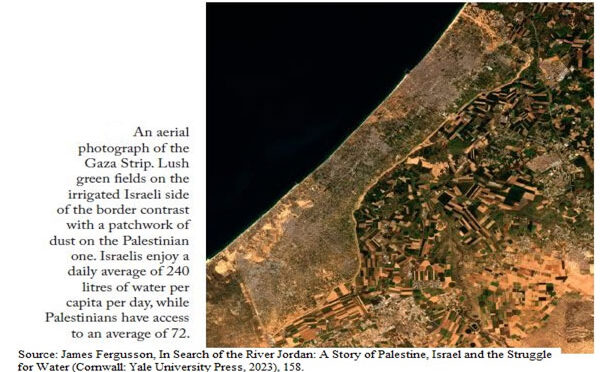Water Scarcity and the Israel-Palestine Conflict
Posted on : November 20, 2023Author : Rashid Abbasi

Water is life. It is crucial for the survival of humans, animals and plants. After the beginning of war between Israel and Palestine,Israel announced a total disconnect of electricity, food and fuel for the civiliansin Gaza on 9 October 2023, thecollective punishment justified by Israeli Defense Minister “We are fighting human animals and we are acting accordingly.” Later Israel’s Energy Minister Israel Katz announced that the water supplyto Gaza to be cut off completely. The direct violencethat we have seen in the warhas highlighted the deepstructural violence that Palestinians have been going through for a long time that includes denying even the most fundamental necessities such as water. There are three main areas of water resources in the region. First is the Jordan River basin water resources that also led to conflict between Israel and its Arab neighbours(known as War over Water from 1964-67). Palestinians are denied any access to this water since Israel occupied the West Bank in 1967 diverting the river flow to Israel. Second are the groundwater resources originating in the West Bank that are directed to the lowlands of Israel and totheillegal settlements. Third are the groundwater resources in the Gaza strip, which partially originate in Israel and are over-exploited and polluted.
Israel has acquired complete authority over the water resources in the region, encompassing both surface and groundwater either through direct force or through peace treaties. These treaties have established negative peace by denying the equal level of security to the Palestinians. For example, the Oslo Accords (pair of agreements signed in 1993 and 1995) institutionalized Israeli control of resources. Edward Said writes that during the negotiation of Oslo Accords, Israeli attitude towards Palestinian diplomats was contemptuous and ungenerous. He arguesthat on all matters having to do with “security, sovereignty, water, settlements, and Jerusalem, the Palestinians have in effect gained nothing.” American political scientist and activist Norman Finkelstein also points out thatPalestinians have brought into a condition of permanent state of negotiationswith Israel over water resources as they are deprive the right to have ‘ownership of water.’ He adds, “Israel already claims legal title to most of the West Bank water on the basis of ‘historic usage’.That is, having stolen Palestinian water for nearly three decades, Israelis now proclaim it is theirs.” Israel extracted 80% more water than the agreed, while Palestine followed the agreed range.
Accepting the reality of power differentials. Palestine has sought to find alternative ways provide Water Security to the people. Water Security is defined as the sustained access of individuals to sufficient safe water for health and well- being andthe World Health Organization has set 100 litres per day as the minimum daily per capita water consumption standards for basic Water Security of an individual. During peacetime, Palestine falls short of meeting the minimum daily per capita standard.
“Israelis enjoy an average of 240-340 liters of freshwater per capita per day, while Palestinians have access to an average of 72liters. In some parts of the Occupied Territories, where a great many communities are not even connected to the mains, availability is as low as 25 liters per capita per day.”
One way to deal with the water crisis in Gaza had been to utilize the sea water with the help of desalinization plant. A report by Israeli newspaper Haaretz suggested that, “water scarcity had always been a serious problem in Gaza and people had access to electricity for only about two hours a day.” While Gaza is heavily dependent on the underlying coastal aquifer as its primary water source, frequent power cut Gaza has eliminated desalination as a viable option to generate sufficient amount of water. Additionally, this aquifer has been criticallycompromised by severe contamination from sewage and intrusion of seawater. According to Israeli-Palestinian NGO, Eco Peace, “97 % of the water within the Gaza aquifer is unsuitable for consumption due to elevated salinity levels.” The escalating water scarcity is also a consequence of the growing number of settlers in the region. According to James Ferguson, Israeli settlers typically consume twenty times as much water, per capita, as their West Bank Arab neighbors.” More than 85% of these resources have been employed by Israel and Israeli settlements, leaving a mere 15% for the Palestinian population residing in the West Bank and Gaza.
The water issue has impacted agriculture, food production, health issues in Palestine. Most intense effect is on the crop area changes due to decreases in optimal farming conditions. One Palestinian farmer, Issar Nijoum, shared that he transitioned to cultivating less water-intensive crops like squash and cucumbers, as he had water access for only 40 days during the typical growing season. Nijoum expressed that in 1967, when “they [the Israeli authorities] started taking the water it was like a sickness in a body… slowly the land dried up.” Aerial photography of the Gaza Strip provides compelling evidence supporting the claims of local farmers. The following image vividly illustrates the extensive damage inflicted upon Gaza’s water, soil, and air, highlighting the region’s environmental degradation.
This reduction has strained water resources as well as increased the vulnerability of the region to drought and water scarcity. According to UN report the elevated areas of the West Bank, has good amount of renewable water resources compared with most areas in the Middle East., “Although the water situation in the Gaza Strip is very serious, under normal conditions the annual replenishment of water in the West Bank would be more than adequate for the present and future needs of a much larger Palestinian population.” However, Israel’s constraints on the freedom of movement especially among Palestinians of two sides also include prohibiting water supply by West Bank to Gaza. As Israel prefers the two sides of Palestinian population to remain divided.
Palestinians authorities, by necessity, are trying to adapt to environmental challenges they already face by involving in several projects. One of the key strategies was developed with the help of the United Nations Development Fund (UNDP) in 2010. It emphasized several significant discoveries and critical observations about climate change in the Occupied Palestinian Territories (OPT), particularly the lack of water security in Gaza. The report highlighted six key climate-induced risks to food and water security were identified for the West Bank and the Gaza Strip that are linked to water issue:
1. “Crop area changes due to decreases in optimal farming conditions
2. Decreased crop and livestock productivity
3. Increased risk of floods
4. Increased risk of drought and water scarcity
5. Increased irrigation requirements
6. Increased risks to public health from reduced drinking water quality (including saline intrusion in the GazaStrip)”
The drought that is now faced by Palestinians is ‘political drought’ that is a result of occupation. This political drought has the potential to turn into a meteorological or hydrologicalcrisis. The Israeli settlements exacerbate environmental damage through ongoing construction, an increase in the settler population, and incidents of settlers setting fire to Palestinian greenery in the West Bank.Since 1967,the Israeli authorities have uprooted over 800,000 Palestinian olive trees. In the month of August 2021, over 9,000 trees were uprooted, in the West Bank area. The frequent destruction of trees and crops have not only breach Israel’s responsibility as a trustee but also impede the Palestinians’ ability to foster environmental and economic development.Excessive pumping of water from under the ground combined with wastewater has deteriorated drinking water quality in Gaza.This degradation presents significant risks among Gazans by spreading infections like cholera, dysentery and diarrheal diseases. Along with various critical infrastructure, Israel has targeted water pumps and wastewater treatment plants. The systematic destruction of Gaza’s ecosystem through various means might render the land uninhabitable.However, this will not discourage Palestinians from holding on to their homeland. Exploiting natural resources, critical infrastructure and killing of civiliansby will not facilitate Israel in resolving the conflict. Instead this actions will lead to a wide range of humanitarian, political as a well environmental consequences.
According to the Common Article 33 of the Geneva Conventions: “No person may be punished for acts that he or she did not commit. It ensures that the collective punishment of a group of persons for a crime committed by an individual is forbidden.”
Emanuel Fabian, https://www.timesofisrael.com/liveblog_entry/defense-minister-announces-complete-siege-of-gaza-no-power-food-or-fuel/. The Times of Israel, 9 Oct 2023.
Amnesty International, ‘Troubled Waters- Palestinians denied Fair Acess to Water’, 2009, https://www.amnesty.org/en/documents/mde15/027/2009/en/.
Edward Said, Peace and its Discontents: Essay of Palestine in the Middle East Peace Process (New York: Vintage Books, 1995), 63.
Norman G. Finkelstein, Image and Reality of the Israel-Palestine Conflict (London: Verso, 2003), 142.
United Nations Water , “What is Water Security?”, , 8 May 2013, https://www.unwater.org/publications/what-water-security-infographic.
James Fergusson, In Search of the River Jordan: A Story of Palestine, Israel and the Struggle for Water (Cornwall: Yale University Press, 2023), 158.
Naama Riba, Even Before the War, Water in Gaza Was Not Enough to Shower’, Haaretz, Oct 25, 2023, https://www.haaretz.com/middle-east-news/palestinians/2023-10-25/ty-article-magazine/.premium/the-discourse-of-revenge-dehumanizes-an-entire-population/0000018b-6645-d2a9-afeb-667d5e5e0000,
Eco-Peace- Middle East, ‘WaterResilience,’ https://ecopeaceme.org/water-resilience/.
James Fergusson, In Search of the River Jordan: A Story of Palestine, Israel and the Struggle for Water (Cornwall: Yale University Press, 2023), 48.
Ibrahim Fares and Yasmin Mansour, ‘Water Issues and Climate Change in the Israeli-Palestinian Conflict’, Jurist, July 16, 2020, https://www.jurist.org/commentary/2020/07/ibrahim-fares-climate-change-israel-palestine/.
Amnesty International, ‘The Occupation of Water’, November 29, 2017, https://www.amnesty.org/en/latest/campaigns/2017/11/the-occupation-of-water/.
United Nations: The Question of Palestine, ‘Water Resources of the Occupied Palestinian Territory’, 1992, https://www.un.org/unispal/document/auto-insert-197919/.
Kasim M. Abdo, ‘Drought Condition and Management Strategies in Palestine’, UN- Water Activity Information System,https://www.ais.unwater.org/ais/pluginfile.php/605/mod_page/content/23/Palestina.pdf.
Layla Hedroug, ‘Israel’s Campaign Against Palestinians Olive Trees,’ The Yale Review of International Studies, March 2023, http://yris.yira.org/global-issue/6018#:~:text=Since%201967%2C%20more%20than%20800%2C000,West%20Bank%20region%20of%20Salfit..
Ciara Nugent, A CeasefireWon’t Protect Palestinians from Looming Climate Threats- or Israel from the Fallout, Time, May 26, 2021, https://time.com/6051323/palestinians-israel-conflict-climate-change/.
Rashid Abbasi
Intern, Asia in Global Affairs
The originality of the content and the opinions expressed within the content are solely the author’s and do not reflect the opinions and beliefs of the website.





Leave a Reply